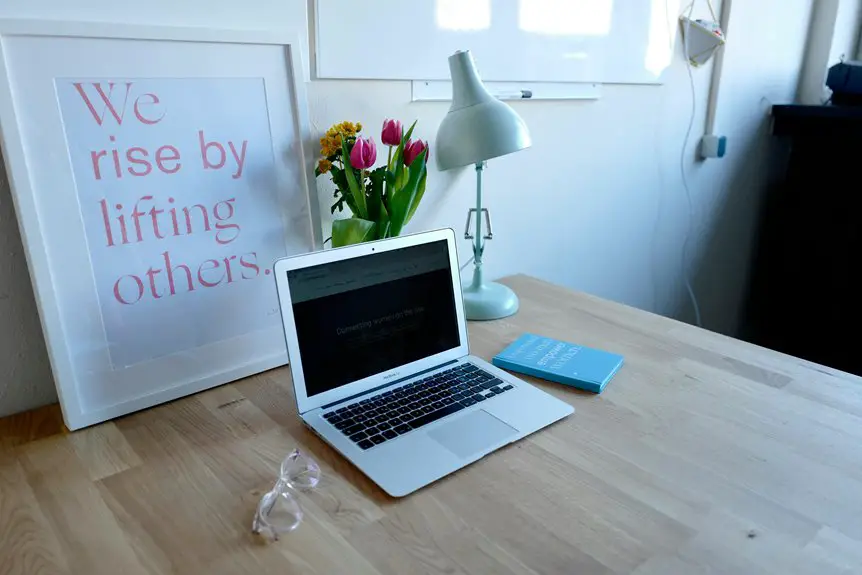For the ergonomic placement of your whiteboard, aim for a height of 4 to 5 feet from the floor to promote comfort for everyone. Ensure it's positioned centrally in your workspace so all participants can see and engage easily. Utilize proper lighting to enhance visibility, avoiding glare from direct sunlight. Lastly, keep markers within reach to maintain flow during discussions. Want to ensure you've got all the details covered? There's more valuable insight to explore!
Table of Contents
Key Takeaways
- Position the whiteboard at a height of 4 to 5 feet to ensure comfort and accessibility for all users.
- Maintain clear sightlines to the whiteboard from all seating positions to enhance visibility and engagement.
- Use adjustable task lighting to focus on the whiteboard while avoiding glare from natural light.
- Arrange seating in a circular or semi-circular format to promote interaction and collaboration around the whiteboard.
- Keep markers and erasers within easy reach to facilitate smooth communication and participation during discussions.
Understanding Ergonomics in Workspace Design
When you design a workspace, understanding ergonomics is crucial because it directly impacts your comfort and productivity. You want to create an environment that reduces strain and enhances efficiency.
Start by evaluating your desk height and chair position; they should allow your feet to rest flat on the floor while keeping your elbows at a 90-degree angle. Consider the distance from your screen too; it should be about an arm's length away, minimizing eye strain.
Lighting matters as well; ensure your workspace is well-lit to avoid glare. Lastly, don't forget about movement—incorporate breaks and stretches to keep your body active.
Ideal Height for Whiteboard Placement
The ideal height for whiteboard placement typically falls between 4 to 5 feet from the floor, ensuring that everyone can easily reach and write on it without straining.
When you set the board at this height, you promote comfort and accessibility for all users, whether they're standing or sitting.
To determine the perfect height for your space, consider the average height of your team members. If you have a diverse group, aim for a mid-range height that accommodates most.
Additionally, ensure that the whiteboard is positioned in a way that allows clear visibility from various angles in the room. This way, everyone can engage with the content effectively, maximizing collaboration and productivity during discussions.
Optimal Lighting Conditions for Visibility
How can you ensure that your whiteboard is visible to everyone in the room? Optimal lighting conditions play a crucial role. Here are some tips to enhance visibility:
- Natural Light: Position the whiteboard near windows, but avoid direct sunlight, which can create glare.
- Ambient Lighting: Use soft overhead lights to evenly illuminate the area without harsh shadows.
- Task Lighting: Consider adding adjustable lighting, like lamps, to focus on the whiteboard during presentations.
- Minimize Reflections: Choose matte finishes for the whiteboard surface to reduce reflections that can obscure writing.
Ensuring Accessibility for All Users
Creating an environment where everyone can engage with the whiteboard is vital for effective communication and collaboration. To ensure accessibility for all users, consider the following factors:
| Factor | Consideration | Action |
|---|---|---|
| Height | Adjustable or fixed | Install at eye level |
| Visibility | Clear sightlines | Avoid obstructions |
| Reachability | Easy access | Place markers and erasers nearby |
Strategic Positioning for Collaboration
While positioning the whiteboard for collaboration, it's crucial to consider how the layout of the room influences interaction.
You want to create an environment where everyone can engage easily. Here are four key strategies:
- Central Location: Place the whiteboard in a central spot, visible to all participants.
- Group Seating: Arrange seating in a circular or semi-circular format to promote eye contact and open dialogue.
- Accessible Height: Ensure the whiteboard is at a height that allows everyone to reach it comfortably.
- Minimize Distractions: Choose a wall that reduces visual distractions, helping everyone focus on the discussion.
Maintenance and Upkeep of Your Whiteboard
After setting up your whiteboard for optimal collaboration, keeping it in good condition is just as important. Regularly wipe it down with a dry erase cleaner to prevent stains and ghosting.
Use soft cloths or microfiber to avoid scratches. If you notice any marks that won't budge, consider using a magic eraser for a deeper clean.
Ensure you're using high-quality dry erase markers, as low-quality ones can leave residue. Store markers horizontally or upright to keep the ink flowing smoothly.
Don't forget to check the board's mounting and hardware periodically to ensure it remains secure.
Frequently Asked Questions
What Materials Are Best for Writing on Whiteboards?
For writing on whiteboards, you'll find dry-erase markers work best. They're easy to wipe off and come in various colors. Avoid using permanent markers, as they'll leave stains that are hard to remove.
Can I Use a Whiteboard in a Small Room?
Absolutely, you can use a whiteboard in a small room! Just ensure it's mounted at a comfortable height, and choose a compact size that fits your space without overwhelming it. Your creativity will thrive!
How Do I Clean Stubborn Stains From My Whiteboard?
To clean stubborn stains from your whiteboard, use a mixture of rubbing alcohol and water. Apply it with a cloth, scrub gently, and wipe clean. For tough spots, try dry-erase cleaner or magic erasers.
Are There Specific Whiteboard Sizes for Different Tasks?
Yes, different tasks benefit from specific whiteboard sizes. For brainstorming, larger boards work best, while smaller boards suit quick notes or small group discussions. Choose the size that fits your needs and available space effectively.
What Accessories Enhance the Usability of a Whiteboard?
To enhance your whiteboard's usability, consider adding markers, erasers, magnetic strips, and clipboards. These accessories help you organize ideas, keep notes handy, and ensure smooth writing and erasing, making your sessions more efficient and productive.




